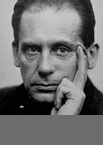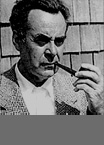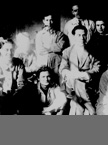The modern movement in architecture and industrial design, which emerged in the early 20th century, responded to sweeping changes in technology and society. A new world of machines and cities forced artists to think anew about their environment, and soon revolutionized the way we perceive, portray, and participate in the world. Modernist ideas have pervaded every form of design, from graphics to architecture, as well as being a key influence on art, literature and music.
Many modern designers insisted that they followed no "style." And indeed modernism was more than a style, it was a new worldview, conditioned by new perceptions of time and space. But even though there were ways of expressing that worldview, these are the hallmarks of modern design: an interest in exploring new materials, a rejection of historical precedents, and a simplification of forms by a reduction of ornament.
Our word modern comes from the Latin modernus, which meant "just now," although the term was not widely used before the 1500s, when it provided a way of distinguishing the period after the Renaissance from the ancient and medieval worlds. It also meant "new-fashioned, not antiquated or obsolete." Then, towards the end of the 1800s, the term became more closely attached to the "new art" of the coming twentieth century.
Virginia Woolf famously designated 1910 as the year in which those changes coalesced into a cultural revolution: "in or around December, 1910," she wrote, "human character changed." In his provocative paper "What Was Modernism?" critic Robert Adams agreed with Woolf, identifying the Postimpressionist show at the Grafton Galleries in London as modernism's first defining moment: "Within five years either way of that date a great sequence of new and different works appeared in Western culture, striking the tonic chords of modernism. Ten years before that fulcrum of December 1910, modernism is not yet; ten years after, it is already."
The ideology of modernism had several sources. One of the earliest was the English artist William Morris, whose writings formed the basis for the arts and crafts movement. Morris advocated a return to well-made, handcrafted goods instead of mass-produced, poor quality machine-made items. In his famous statement, "Have nothing in your house that you do not know to be useful, or believe to be beautiful," Morris outlined the modern belief that utility was as important as beauty.
Another important figure in this development, and the first great modern architect, was the American Louis Sullivan, who coined the phrase "Form Follows Function." For Sullivan, functionalism meant the elimination of ornament so the building plainly expressed its purpose, and the principle led to the idea of designing buildings from the inside outwards, letting the essential structure dictate the form and therefore its external appearance.
Viennese architect Adolf Loos, following Sullivan, insisted that functional objects should not be decorated; to do so was a waste of effort, material, and capital. He wrote a manifesto entitled "Ornament and Crime," in which he argued that the avoidance of ornament was "a sign of spiritual strength." This essay became one of the foundation texts for the modern movement.
The Wiener Werkstätte (German for the "Vienna Workshop") also offered important contributions to the development of modernism. Its founders, architect Joseph Hoffman and painter Koloman Moser, formed this movement in 1903. It was dedicated to developing high quality art and design to be brought into people's daily life, a philosophy which reflected the influence of William Morris. Reacting against historicism, the Wiener Werkstätte employed simplified shapes, geometric patterns, and minimal decoration. A great deal of attention was put on fine craftsmanship. This followed the group's motto: "Better to work ten days at one piece than to manufacture ten pieces in one day."
But by the 1920s, modern designers began to embrace new technologies and the possibility of mass production; the aesthetic of the machine then became a central theme in modernism. Two figures in particular promoted the language of industry: Walter Gropius and Le Corbusier.
Gropius was the leader of the Bauhaus, the school of art and architecture in Germany. The Bauhaus revolutionized art training by combining the teaching of the pure arts with the study of crafts. Gropius aimed to unite art with technology, and he educated a new generation of designers and architects to reject historical precedents and adopt the ideology of modern industry. For the Bauhaus, Gropius wrote the curriculum, designed the building, and he assembled its faculty: an extraordinary group that included Paul Klee, Lyonel Feininger, Wassily Kandinsky, László Moholy-Nagy, and Marcel Breuer.
Le Corbusier, probably the most influential modern architect, introduced a fascination with the designs of engineers, such as grain silos, cruise ships, and automobiles. His radical ideas were given full expression in his 1923 book Vers Une Architecture ("Towards a New Architecture"), an impassioned manifesto. It is still the best-selling architecture book of all time, and it includes Le Corbusier's famous motto: "A house is a machine for living in."
In the 1930s, many of the leading European modernists emigrated to the United States; thus the theory and practice of Modernism became widespread. The 'tradition of the new', as Richard Weston called it, became the dominant mode of progressive artists. What had begun as a cluster of loosely related artistic movements scattered across Europe emerged as the dominant style of the 20th
century.
Anthony S. Denzer, Ph.D.
|
|
|
info@mastersofmodernism.com1 800 450 0405



